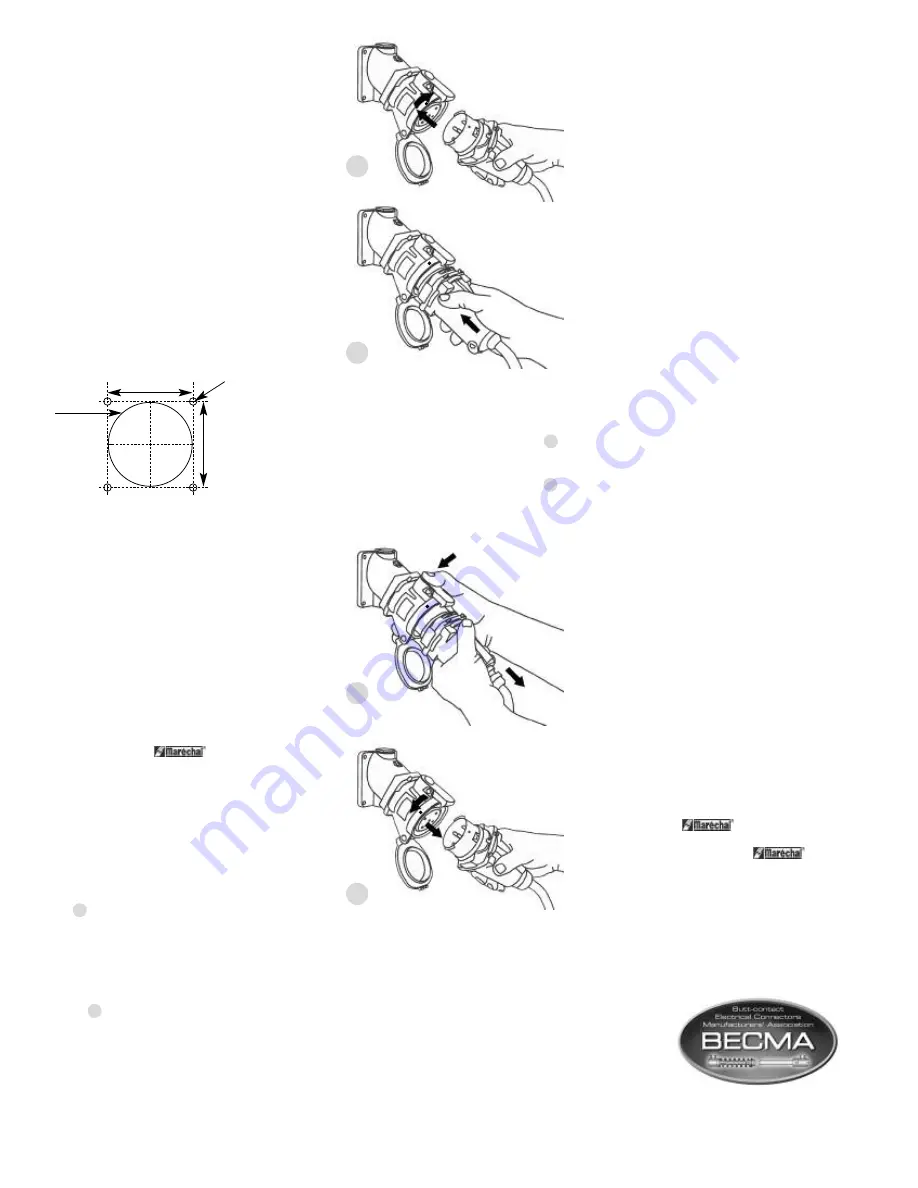
screws on the receptacle (or inlet) far enough (but
not completely) to allow the conductors to pass,
insert the conductors fully into their respective ter-
minals and tighten the terminal screws to the
torque indicated in Table 3, with a hand screwdriver.
Assemble the receptacle (or inlet) and the color-
coded gasket to the box with appropriate hardware.
(
CAUTION
– over-tightening the screws may
cause cracking in polymeric components).
Assemble the mating plug (or receptacle) to the
cord end as indicated in the assembly instructions
above for in-line connections, except there will be
no finger drawplate or associated black gasket.
In cases where custom mounting is being per-
formed to an appropriate hazardous duty box or
panel, the clearance and mounting holes should be
drilled as indicated in the following diagram.
Hole Pattern for Custom Mounting
In order to maintain IP66/67 protection in custom
installations, watertight seals must be used under
the heads of the four mounting bolts and they must
be retained by a lock washer and nut on the inside
of the box or panel. Alternatively, four blind holes
can be drilled and threaded to accommodate #8-32
x 5/8” mounting screws. The hole depth must be
sufficient to achieve adequate gasket compression.
OPERATION
To ensure safe and reliable operation, Meltric plugs
and receptacles must be used in accordance with
their assigned ratings. They can only be used in
conjunction with mating receptacles or plugs man-
ufactured by Meltric or another licensed producer
of products bearing the trademark.
Meltric plugs & receptacles are designed with dif-
ferent keying arrangements, so that only plugs and
receptacles with compatible contact configurations
and electrical ratings will mate with each other.
Connection
To connect a plug and receptacle, first depress the
pawl to open the lid on the receptacle, then orient
the plug 1 so that the red dot on the outside of the
casing lines up with the red dot just to the left of the
latch on the receptacle casing. Push the plug partially
into the receptacle until it hits a stop, then rotate the
plug in the clockwise direction until it hits another
stop after about 30° of rotation. At this point, the
circuit is still open. Push the plug straight into the
receptacle 2 until it becomes securely latched in
place. The connection is now made. On in-line
connectors, squeeze the drawplates on both sides
of the device together until the plug latches in place.
Disconnection
To break the connection, depress the pawl and
simultaneously pull the plug straight out 3 to the
rest position. The circuit is broken. To withdraw
the plug, simply rotate it counter-clockwise (about
30°) until it releases from the receptacle 4. Close
and latch the lid on the receptacle.
Partial Compatibility with the DSN Series
All DXN1 plugs and DXN3 plugs without auxiliary
contacts are compatible with similarly rated Meltric
DSN1 and DSN3 series receptacles for non-haz-
ardous locations. This allows hazardous location
equipment to additionally be used in non-haz-
ardous areas. DXN6 plugs do not have similar
compatibility with DSN6 receptacles.
Lockout Provisions
All DXN plugs are provided with lockout provisions.
To lockout the plug, insert the locking device
through the hole provided in the casing. This will
prevent the plug from being able to be inserted into
a receptacle.
DXN’s may also be purchased with optional lockout
provisions for the receptacle. To lockout the receptacle,
close and latch the lid and then attach the locking
device through the hole provided in the latch. This
will prevent the lid from being opened.
NOTE:
Attaching the receptacle locking device
with the lid open will not prevent the insertion of a
plug. Lockout is only accomplished when the lid is
locked closed.
MAINTENANCE
Meltric products require little on-going maintenance.
However, it is a good practice to periodically per-
form the following general inspections:
• Check the mounting screws for tightness.
• Verify that the weight of the cable is
supported by the strain relief mechanism
and not by the terminal connections.
• Check the IP gaskets for wear and resiliency.
Replace as required.
• Verify the electrical continuity of the
ground circuit.
• Check the contact surfaces for cleanliness
and pitting.
Deposits of dust or similar foreign materials can be
rubbed off the contacts with a clean cloth. Sprays
should not be used, as they tend to collect dirt. If
any significant pitting of the contacts or other seri-
ous damage is observed, the device should be
replaced.
MANUFACTURER’S RESPONSIBILITY
Meltric’s responsibility is strictly limited to the repair
or replacement of any product that does not conform
to the warranty specified in the purchase contract.
Meltric shall not be liable for any penalties or con-
sequential damages associated with the loss of
production, work, profit, or any other kind of financial
loss incurred by the customer.
Meltric Corporation shall not be held liable when its
products are used in conjunction with products not
bearing the trademark. The use of Meltric
products in conjunction with mating devices that
are not marked with the trademark shall
void all warranties on the product.
Meltric Corporation is a member of the international
association, BECMA: the Butt-contact Electrical
Connectors Manufacturers Association.
1
2
3
4
DXN1: 1.656”
(
42mm
)
DXN3: 1.890”
(
48mm
)
DXN6: 2.171”
(
55.2mm
)
DXN1: 2.00”
(
51mm
)
DXN3: 2.25”
(
56mm
)
DXN6: 2.50”
(
64mm
)
DXN1: 1.656” (
42 mm
)
DXN3: 1.890” (
48 mm
)
DXN6: 2.171” (
55.2 mm
)
4 x Ø.196
(
#9 or 5mm
)
CUSTINFO/DXN
Coutesy of Gross Automation 1724 South Johnson Road New Berlin, WI PH: 262-446-0000 FAX: 262-446-0300 www.meltricsales.com




















